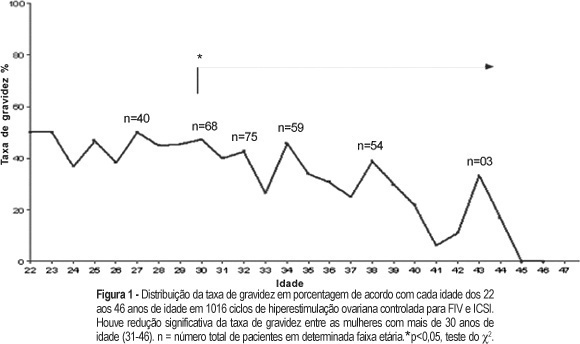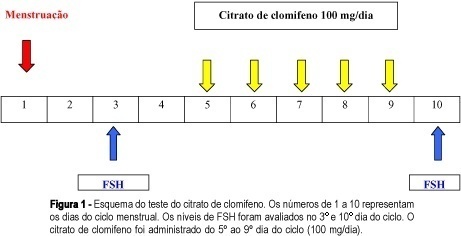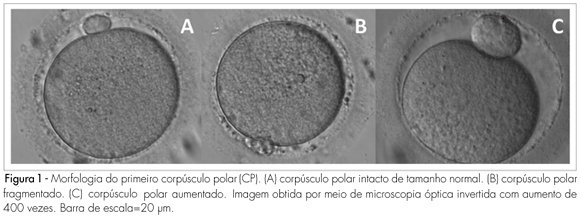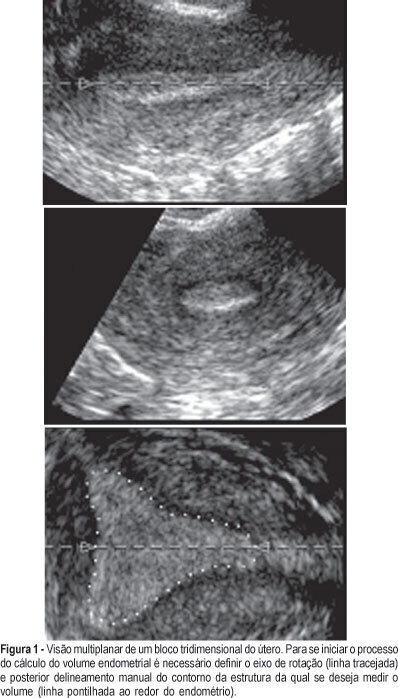You searched for:"Rui Alberto Ferriani"
We found (49) results for your search.Summary
Rev Bras Ginecol Obstet. 2011;33(6):310-316
DOI 10.1590/S0100-72032011000600008
PURPOSE: To compare the metabolic characteristics of obese and non-obese young women with polycystic ovary syndrome (POS) from the Brazilian Southeast. METHODS: This was a cross-sectional study conducted on 218 women of reproductive age with a diagnosis of POS - 90 non-obese women (BMI between 18.5 and 29.9 kg/m²), and 128 obese patients (BMI >30 kg/m²) selected at the time of diagnosis. The frequency of insulin resistance (IR), glucose intolerance (GI), metabolic syndrome (MetS) and type 2 diabetes mellitus (DM2) and mean values of total cholesterol (TC), triglycerides (TG), high-density (HDL) and low-density lipoproteins (LDL), were compared between obese and non-obese patients with POS. The two groups were also compared in terms of clinical and hormonal characteristics (follicle stimulating hormone, prolactin, thyroid stimulating hormone, total testosterone, dihydroepiandrostenedione sulfate, and 17-hydroxyprogesterone). Statistical analysis was performed using the SAS 9.0 software. Quantitative variables were compared by the Student´s t-test (data with normal distribution) or by the Mann-Whitney test (non-parametric distribution). Qualitative variables were compared by the Fisher test. The level of significance was set at 5% (p<0.05) in all analyses. RESULTS: The frequency of IR, GI and MetS was significantly higher in obese than non-obese patients with POS (66.7, 29.9, and 63% versus 24.7, 12.2, and 16.4%, respectively). Obese patients had higher TC and TG levels (189.8±35.8 mg/dL and 145.4±71.1 mg/dL, respectively) than non-obese patients (172.1±38.4 mg/dL and 99.3±54 mg/dL, respectively). Both groups had mean HDL levels below 50 mg/dL. CONCLUSIONS: Young obese women with POS have a higher frequency of IR, GI and MS than non-obese. However, the occurrence of metabolic disorders is elevated also in the non-obese patients, suggesting that the presence of the syndrome may favor the development of metabolic comorbidities with potential medium- and long-term repercussions.
Summary
Rev Bras Ginecol Obstet. 2006;28(1):32-37
DOI 10.1590/S0100-72032006000100006
PURPOSE: to evaluate the rate of chemically diagnosed pregnancy (serum beta-HCG>25 mIU/mL levels obtained fourteen days after the embryonic transfer) clinically diagnosed pregnancy (gestational sac visualized by ultrasound four to six weeks after the embryonic transfer) and miscarriage rates in women submitted in vitro fertilization to (IVF) and intracytoplasmic sperm injection (ICSI) in a tertiary center of assisted reproduction and to correlate these rates with age. METHODS: retrospective transverse study with analysis of 1016 cycles of controlled ovarian hyperstimulation of 932 infertile women with indication of IVF (370 cycles) or ICSI (646 cycles). The patients' age ranged from 22 to 46 years. All women with age over 35 years included in the study had FSH<15 IU/L. The studied cycles were divided into two groups: the first including the cycles referring to women of 22 to 30 years and the second group, to those of 31 to 46 years. The studied variables were: pregnancy (chemical or clinical) and miscarriage rates. The chi2 test was used to compare these rates between the groups. RESULTS: the total pregnancy rate was 36.42%, with a significant reduction starting at 30 years (p=0.0001). From 22 to 30 years (303 cycles) the pregnancy rate was 45.4%, while in the range from 31 to 46 years (713 cycles), it was 25.1%. The miscarriage rates were, 10.2 11,6%, respectively (p=0.6854). CONCLUSION: although the miscarriage rates did not differ between the groups, a decrease in the pregnancy rate of infertile women submitted to IVF or ICSI was observed after the age of 30 years. Thus, we recommend the gynecologists not to postpone the investigation and the referral for treatment of infertility.

Summary
Rev Bras Ginecol Obstet. 2002;24(5):323-327
DOI 10.1590/S0100-72032002000500006
Purpose: to assess ovarian reserve by FSH determination on the 3rd day of the menstrual cycle compared to the clomiphene test and to correlate the results with the ovarian response to controlled hyperstimulation with gonadotrophins for in vitro fertilization. Methods: a total of 49 patients older than 30 years who had been presenting a clinical picture of infertility for at least 1 year were selected. All patients were evaluated for ovarian reserve by the clomiphene citrate test and 26 of them were later submitted to controlled ovarian hyperstimulation with gonadotrophins. Of these 26 patients, 18 showed a good response to ovarian hyperstimulation and 8 showed a poor response. Mean (+ SD) FSH values were calculated for the determinations on the 3rd and on the 10th day and for their sum in the group of patients who responded favorably to ovarian stimulation, and were later correlated with the ovarian response after gonadotrophin stimulation. Results: employing a FSH value > 16.1 IU/mL on the 10th day (mean plus 2 SD) for the prediction of a poor ovarian response in the clomiphene test, the sensitivity, specificity, and positive and negative predictive values of this parameter were 50, 100, 100 and 81.8%, respectively. Considering the clomiphene test to be positive when the sum of the FSH values determined on the 3rd and 10th day plus 2 SD was > 22.6 IU/mL, we obtained 62.5% sensitivity 100% specificity, 100% positive predictive value, and 85.7% negative predictive value. A single FSH determination of 10 IU/mL on the 3rd day of the cycle for the prediction of a poor ovarian response showed 87% sensitivity, 100% specificity, 100% positive predictive value and 94.7% negative predictive value. Conclusion: in the present study, a single FSH determination on the 3rd day of the cycle showed to be more sensitive than the clomiphene test for the evaluation of ovarian reserve.

Summary
Rev Bras Ginecol Obstet. 2016;38(7):340-347
Aerobic exercises may improve quality of life (QoL) in women with polycystic ovary syndrome (PCOS). However, there is no data on the effect of resistance exercise training (RET) programs on the QoL of women with PCOS. Thus, this study aimed to assess the effect of a 16-week RET program on QoL in PCOS women.
This 16-week case-control study enrolled 43 women with PCOS (PCOS group, PCOSG) and 51 healthy pre-menopausal controls aged 18 to 37 years (control group, CG). All women underwent a supervised RET program for 16 weeks, and were evaluated in two different occasions: week-0 (baseline), and week-16 (after RET). Quality of life was assessed using the 36-Item Short Form Health Survey (SF-36).
Testosterone reduced significantly in both groups after RET (p < 0.01). The PCOSG had improvements in functional capacity at week-16 relative to week-0 (p = 0.02). The CG had significant improvements in vitality, social aspects, and mental health at week-16 relative to week-0 (p ≤ 0.01). There was a weak correlation between social aspects of the SF-36 domain and testosterone levels in PCOS women.
A 16-week RET program modestly improved QoL in women with PCOS.
Summary
Rev Bras Ginecol Obstet. 2009;31(7):342-348
DOI 10.1590/S0100-72032009000700004
PURPOSE: to compare echographical cardiovascular risk factors between obese and non-obese patients with micropolycystic ovarian syndrome (MPOS). METHODS: in this transversal study, 30 obese (Body Mass Index, BMI>30 kg/m²) and 60 non-obese (BMI<30 kg/m²) MPOS patients, aging between 18 and 35 years old, were included. The following variables were measured: flow-mediated dilatation (FMD) of the brachial artery, thickness of the intima-media of the carotid artery (IMT), anthropometric data, systolic arterial pressure (SAP) and diastolic arterial pressure (DAP). The women had no previous medical treatment and no comorbidity besides MPOS and obesity. For statistical analysis, the non-paired tand Mann-Whitney's tests were used. RESULTS: obese weighted more than non-obese patients (92.1±11.7 kg versus 61.4±10.7 kg, p<0.0001) and had a larger waist circumference (105.0±10.4 cm versus 78.5±9.8 cm, p<0.0001). The SBP of obese patients was higher than that of the non-obese ones (126.1±10.9 mmHg versus 115.8±9.0 mmHg, p<0.0001) and the IMT was also bigger (0.51±0.07 mm versus 0.44±0.09 mm, p<0.0001). There was no significant difference between the groups as to FMD and carotid rigidity index (β). CONCLUSIONS: obesity in young women with MPOS is associated with higher blood pressure and alteration of arterial structure, represented by a thicker intima-media of the carotid artery.
Summary
Rev Bras Ginecol Obstet. 2008;30(7):360-365
DOI 10.1590/S0100-72032008000700007
PURPOSE: to determine the relationship between the morphology of the first spindle pole of human oocytes and rates of fertilization, fragmentation and embryo quality in procedures of Intracytoplasmic Sperm Injection (ICSI). METHODS: retrospective study of 582 consecutive ICSI cycles, from July 2003 to July 2005. The morphology of the first spindle pole (SP) was assessed through the analysis of 3,177 oocytes in metaphase II, immediately before the ICSI procedure, always by the same observer. SP has been classified in the following categories: normal size intact, fragmented or augmented SP. Fertilization rate and fragmentation, and the number and rate of good quality embryos in each one of the three groups studied have been evaluated, 48 hours after ICSI (D2). Embryos with four cells, without fragmentation and with symmetric blastomeres in D2 were considered as of good quality. RESULTS: rates of fertilization, fragmentation and of good quality embryo formation, resulting from oocyte insemination, with augmented SP (20.7, 16.7 and 5% respectively) were significantly lower than the ones from intact and normal size SP (70.8, 62.5 and 19%, respectively) or from fragmented SP oocytes (69.7, 60.5 and 17.1%, respectively). CONCLUSIONS: it has been observed that the presence of augmented first spindle pole is related to worse rates of fertilization, fragmentation and bad quality embryo formation. Nevertheless, fragmentation in the first spindle pole of the oocyte does not seem to affect ICSI results.

Summary
Rev Bras Ginecol Obstet. 2006;28(1):38-43
DOI 10.1590/S0100-72032006000100007
PURPOSE: to determine the intraobserver and interobserver reproducibility of endometrial volume measurements using the VOCAL®-imaging program (Virtual Organ Computer-aided AnaLysis). METHODS: one three-dimensional (3-D) ultrasound dataset of the endometrium was obtained from each of five infertile women with different endometrial volumes. For each 3-D dataset, the endometrial volume was calculated by two different observers using the manual mode in four different rotational steps (30º, 15º, 9º and 6º). Ten measurements were obtained with each method and observer from each 3-D dataset. We have used one-way ANOVA and the Tukey post-test to verify the differences among means and the intraclass correlation coefficient to test reliability. RESULTS: rotational methods employing a rotation step of 30º were associated with lower endometrial volume readings in 3 of the 5 patients. There were no significant differences between the means obtained by the 15º, 9º or 6º step rotation. No significant difference was found between the means obtained by the two different observers. The intraclass correlation coefficients were significantly lower with 30º (all under 0.984) than with the other step rotations (all above 0.996). CONCLUSIONS: the use of a rotational step of 15º or less provides reliable readings of endometrial volume: there were no significant differences between the means calculated by the two observers, associated with highintraclass correlation coefficient (>0.996). We recommend the 15º step rotation because it is quicker to be performed than 6º and 9º.
